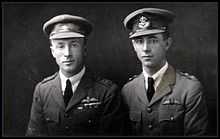Ross Macpherson Smith
| Sir Ross Macpherson Smith | |
|---|---|
 Capt. Ross Smith (left) and brother Lieut. Keith Smith in 1921. | |
| Born |
4 December 1892 Semaphore, South Australia |
| Died |
13 April 1922 (aged 29) Weybridge, England |
| Cause of death | Aviation accident |
| Nationality |
|
| Relatives | Sir Keith Macpherson Smith (brother) |
| Aviation career | |
| Known for | Flying ace, pioneering aviator |
| Famous flights |
Pioneer flight from Cairo to Calcutta Pioneer flight from England to Australia |
| Air force | Australian Flying Corps |
| Battles |
First World War |
| Rank | Captain |
| Awards |
Knight Commander of the Order of the British Empire Military Cross & Bar Distinguished Flying Cross & Two Bars Air Force Cross |
Sir Ross Macpherson Smith KBE, MC & Bar, DFC & Two Bars, AFC (4 December 1892 – 13 April 1922) was an Australian aviator. He and his brother, Sir Keith Macpherson Smith, were the first pilots to fly from England to Australia, in 1919.
Biography
His father migrated to Western Australia from Scotland and became a pastoralist in South Australia. His mother was born near New Norcia, Western Australia, the daughter of a pioneer from Scotland. The boys boarded in Adelaide, at Queen's School, and for two years, in Scotland.

He enlisted in 1914 in the 3rd Light Horse Regiment, landing at Gallipoli 13 May 1915. In 1917, he volunteered for the Australian Flying Corps. He was later twice awarded the Military Cross and the Distinguished Flying Cross three times, becoming an air ace with 11 confirmed aerial victories.
Smith was pilot for T. E. Lawrence (Lawrence of Arabia) and fought in aerial combat missions in the Middle East. He is mentioned several times in Lawrence's book, Seven Pillars of Wisdom, Chapter 114.
In 1919, he and brother Keith, Sergeant James Mallett (Jim) Bennett and Sergeant Wally Shiers flew from Hounslow Heath Aerodrome, England, on 12 November 1919 in a Vickers Vimy, eventually landing in Darwin Australia on 10 December, taking less than 28 days, with actual flying time of 135 hours. The four men shared the £10,000 prize money put forward by the Australian government.
Smith was killed (along with the recently commissioned Lieutenant Bennett) while testing a Vickers Viking amphibian aircraft which crashed in Byfleet soon after taking off from Brooklands on 13 April 1922. Captain Stanley Cockerell, test pilot for Vickers, had flown Smith and Bennett as passengers on the aircraft's maiden flight earlier that day and testified to the inquest that the machine seemed to be in perfect working order. The jury returned a verdict of death by misadventure.[1] The bodies were transported to Australia and Smith was given a state funeral and later buried on 15 June at the North Road Cemetery, Adelaide.
The Australian cricketer Keith Ross Miller was named after Smith and his brother.
Footnotes
- ↑ "Sir Ross Smith's Death: No Failure of the Machine", The Times, 17 April 1922
See also
- England to Australia flight
External links
| Wikimedia Commons has media related to Ross Macpherson Smith. |
- Biography at "Digger History"
- Pilot record at Australian Flying Corps
- Australian Dictionary of Biography
|